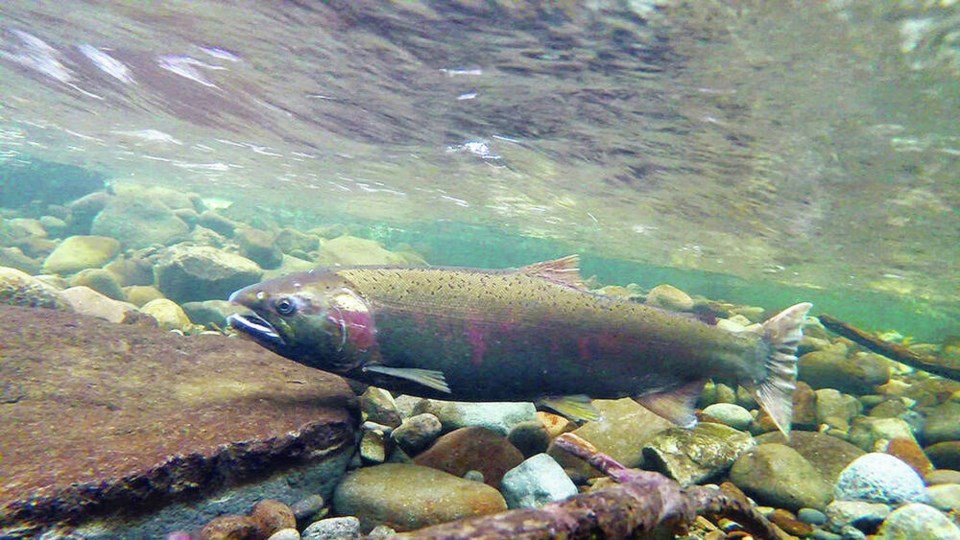Statistics Canada reported this past week that inflation in Canada slowed to 3.1 per cent in October, just above the Bank of Canada’s target range of one to three per cent.
Some economists are predicting that the rate will decrease further this month, with gas prices continuing to fall and food prices still increasing — sigh — but at a slower rate.
If the trend sticks, economists are saying the central bank may start reducing interest rates as early as next spring.
In the short term, however, people with variable-rate mortgages or fixed-rate loans coming up for renewal will see little relief.
Meanwhile, the CRD reported that the water levels in the region’s reservoirs are climbing. Thanks to recent rains, the Sooke reservoir topped 70 per cent capacity last week, and Goldstream is nudging 80 per cent.
This should make salmon returning to local creeks and rivers a bit more comfortable. After another direly dry summer, salmon are pushing upstream to their spawning grounds, albeit still at lower fish-count numbers and through lower water levels than are normal.
Just as inflation and rising interest rates stress people, drought, low flows and warmer water temperatures stress salmon.
With insufficient water, salmon may be unable to beat their way over sandbars. What would normally be rapids that salmon leap through become insurmountable dams.
When salmon return to their birth rivers from their four-year ocean journeys, the fish may stop at the river or stream mouth or in deeper pools of water along the creek to wait for conditions to improve.
While they’re in that holding pattern, they’re easy pickings for hungry otters, seals, bears, osprey and eagles. If there’s no way upstream, they’ll collect and die, as we saw last year in the Neekas River, near Bella Bella.
Soaring costs and rising interest rates over the last couple of years have meant many people may be similarly feeling themselves held at a standstill with no way to navigate forward, no matter how hard they’re working.
Discretionary spending has been whittled to prioritize rent and mortgage payments, food, medications, travel to and from work and school, and so on.
Even people with stable, secure employment have seen losses in real earnings of up to 25 per cent as the cost of living has eaten away at their income.
They’ve taken on extra jobs and side gigs to stay afloat. People lucky enough to have savings are dipping into them. People who retired early in the pandemic are picking up work.
The pendulum has swung from the Great Resignation to the Great Hang-on Until Things Improve — rather like those salmon pooling at the mouths of rivers and in deeper eddies.
(Nature Boy reminds me that when we bought our modest Victoria residence, back around the time T.rex was picking hadrosaur sinew out of its teeth, interest rates were double what they are today. I remind him in turn that those gaspingly high rates followed years of much higher rates and, relatively speaking, were considered a very good deal.)
And, let’s face it, even if interest rates decline next year, things aren’t going to return quickly to the levels they sat at Beforetimes.
Precipitously plummeting interest rates tend to mean something nasty — a global pandemic, for instance — is knocking the economy a-kilter and forcing the central bank to stimulate massive spending to compensate.
As we’ve seen over the last couple of years and in the years leading up to, including and immediately following the 2009 financial crisis and other economic crashes, we, the People, pay the price for that, too.
Nose-diving rates, like crashing consumer confidence, would be the economic equivalent of having a fully loaded atmospheric river stall over the coast for a week after six months of drought.
Yes, we want more water in our rivers and creeks, but the uncontrolled flush-out of watersheds and destabilization of banks and hillsides that result from deluges like the one southern B.C. experienced in late 2021 do harm more than good.
Like salmon awaiting higher river flows before moving upstream, families and communities in a financial holding pattern awaiting better times could be washed out to sea in the economic aftermath.
What we need instead are several weeks of slow, steady, on-and-off regular rain and gradual but steady declines in both inflation and interest rates.



